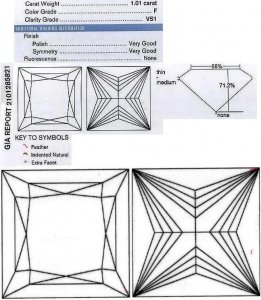Hi there, I would like some opinions from the resident diamond experts on the main stone of a ring I just purchased from bluenile. Please see attached pic with portions of the GIA cert. I made a closeup of the plot and drew over in red to make the inclusions more visible. Now what I am concerned about is the feather on the top right corner. I couldn''t see it from the scan of the GIA cert online when I ordered the diamond (if I could have I wouldn''t have picked this one). I can''t tell but it looks like it goes to the edge, and I''ve heard this can lead to the diamond splitting or chipping. The corner is under a prong. Does this look like a VS1 diamond to you, and should I return this for another diamond before my 30 days are up? I have an appointment with a local appraiser to inspect it, but I thought I would poll the forum aswell.
The setting is here:
Thanks so much for your input.
CMC1.








300x240.png)